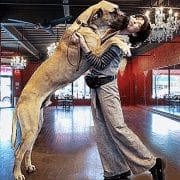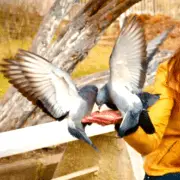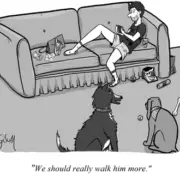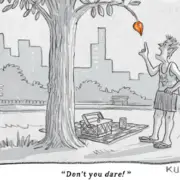Doggy Dancing- A New Cure For Loneliness
NEW YORK CITY – Leave it to New York City to come up with the idea of a dancing school for dogs, … not for the benefit of the dogs, but for the benefit of the people who will wind up being their dance partners. It’s touted as a cure for loneliness.
“Doggy Dancing” is actually the brainchild of Dr. Dan Benzagen, Ph.D. from Columbia University , in New York City.
Dr. Benzagen explains, “people have been using pets to cure their loneliness for hundreds, even thousands of years, but never on such a deep personal level as we have been able to achieve with “Doggy Dancing.”
No more having to turn down invitations to parties because you don’t have a date, or a dancing partner. No more “wallflower” syndrome.
Now you can dance the night away with your dog.
Benzagen continues, “we’ve known for years how smart they are, and how loyal and caring they are. Of all the animals in the animal kingdom dogs may be the smartest, and most loyal, which is why you find seeing-eye dogs, and not seeing-eye anteaters, or seeing-eye ferrets.
Plus, they love the feeling of power they get by standing on their hind legs.”
Dr. Benzagen said he was struck by the power of “Doggy Dancing” himself after coming home one evening after a particularly stressful day, and actually “feeling kind of down.” “I turned on the radio to try and change the mood”, he said, “when this jazzy kind of number came on.”
“My little Shih Tsu Fong ran over, and I instinctively picked him up and began dancing around the living room with him. Within minutes, the most amazing thing happened, I forgot all about my bad mood.
I figured if it could work for me, it could work for my patients too.”
You can either bring your own dog to be trained, or you can have them suggest a breed that’s right for you, and buy it there on the spot, after trying it out for a few dances first, of course. That way you’ll be sure you don’t get a dog that would rather “sit this one out.“
Canine choreographer, Terry Derenzio explains, “breeds will be chosen according to the person’s physical size. Large men may choose to dance with Great Danes, small women may dance with a Collie, or small German Shepherd, according to their preference.”
Because it’s more effective when the dog stands on it’s hind legs rather than just being held in the person’s arms, certain breeds won’t lend themselves to dancing quite as much, like the dachshund, the Yorkshire terrier, and the bulldog.
Other breeds seem to be natural dancers, and just seem to get into the music. “Pomeranians and Poodles love to twirl, and show off, and are good for dances where the partners don’t touch, like the more modern rock and roll dances.”
“For more traditional dances like the Waltz or Fox Trot”, adds Derenzio, “we must rely on the larger breeds like the Doberman Pinschers, the Labradors, and the Rhodesian Ridgebacks, which surprisingly have turned out to be excellent dancers.”
“Pinschers can be a little touchy, and don’t do as well on a crowded dance floor, especially if someone accidentally steps on their paw. Even with training, sometimes their tempers have been known to flare.”
Certain dogs also respond best to certain music. Not surprisingly, the Basset Hound seems to respond best to sad music, while the Irish Wolfhound, a natural partyer, has been known to literally go wild on the dance-floor, often to the point where they have had to be physically removed.
The best part is that dogs are welcome in most places because so many people like them.
Say you get invited to a wedding and you don’t have a date. Most brides really love dogs, and would probably be more than willing to let you bring a dog, especially if they knew it was going to be your dance partner.
Derenzio adds, “… and our dogs are trained not to go for the smorgasbord. “
- About the Author
- Latest Posts
Jeffrey’s a comic and comedy writer who’s written for comedy legends such as Rodney Dangerfield, Joan Rivers, George Wallace, Phil Hartman, Richard Belzer, and Andrew “Dice” Clay, among many others. Jeffrey has performed stand-up at most of the big clubs in NY and L.A. and is known for being a regular on-air personality on Sirius XM’s Bennington Show. He writes a weekly column covering the comedy scene for The Interrobang called “Jumping Around with Jeffrey Gurian”, and has also written for MTV, National Lampoon, and many Friars Roasts. His Comedy Matters TV channel boasts over 450 video interviews with A-listers like Jimmy Fallon, Jim Carrey, Amy Poehler, Amy Schumer and even women NOT named Amy. His crowning achievement was getting his own column in the legendary Weekly World News called “ Gurian’s World of the Bizarre” which led to the creation of GNN (Gurian News Network) bringing you the most unusual stories in The Universe, missed by mainstream media.














